Sun news for January 31, 2024: Huge plasma column, 40 to 50 Earths long
The EarthSky sun news team created this video for you. Hope you enjoy it! If you do, please subscribe or share!The fiery regions we’ve highlighted throughout this week, on the sun’s northwest and southeast horizons, have kept up the show. And this morning we saw a huge jet of sun-stuff erupting from the sun’s southeast! This great column was made of solar plasma, a substance not found often on Earth … sometimes called a “4th state of matter” after solids, liquids and gas. Solar plasma contains both particles and magnetic fields. It’s what interacts with the interplanetary environment of our solar system to create space weather. Today’s column of plasma extended 40 to 50 Earth-diameters into space! The GOES-R SUVI space telescope, which has a much wider field of view than the Solar Dynamics Observatory (SDO), captured this massive blast, as seen in the images at the top of this post.
Last 24 hours: Low sun activity levels continue, with 13 C-class flares fired between 11 UTC yesterday and 11 UTC today. The largest was a C5.7 flare from active region AR3559 at 17:40 UTC. Firing 6 C flares from beyond the solar limb (edge), it seems this sunspot region doesn’t want to leave! The flares it is producing will be larger than what we can observe, as the horizon is blocking part of the emitted light. The sun currently has four sunspot regions on its Earth-facing side, including three newcomers: AR3566, AR3567, and AR3568.
Sun news for January 30, 2024: Double fun! Activity on 2 sides
The EarthSky sun news team produced this video for you. Hope you enjoy it!
Yesterday’s excitement of an M6.8 flare – with its corresponding solar particle storm at Earth – has extended into today. That big blast happened on the northwest solar limb, the edge that’s receding from our view, and there’s continuing action on that edge of the sun today. What does the sun care, after all, about the length of our earthly days? Hence AR3559 in the northwest is displaying energetic jets and huge loops of condensing plasma, aka coronal rain. These loops appear to have formed after the M6.8 flare, and so sun scientists call them post-flare loops. Meanwhile on the sun’s opposite limb – the side that’s now coming into view – we’ve seen a dancing prominence and accompanying jets of plasma. Double fun in the west and east over the past day! Stay tuned to see if this solar symphony reaches another crescendo.
Last 24 hours: Sun activity is back to low after the production of only C class flares during the past day. Between 11 UTC yesterday and 11 UTC today, the sun released 16 C flares. The largest of the period was a C6.0 flare by AR3559 at 14:56 UTC. The S1 radiation storm associated with yesterday’s M6.8 flare has started to wane. AR3559, now over the western limb (edge), could still produce some interesting activity. The sun currently has three sunspot regions on its Earth-facing side.
Sun news for January 29, 2024: Solar particle storm happening now
The EarthSky sun news team produced this video for you. Thanks for watching!In the words of Paul Atreides of Frank Herbert’s Dune … The sleeper has awakened! The quiet sun days are over and departing sunspot region AR3559 is going out with a pop! It released a huge eruption just over the sun’s northwest limb (edge) earlier today. The eruption produced a large brightening, an M6.8 solar flare, bringing sun activity levels to high. This flare’s beauty was in its subtlety, as well as its strength. Large coronal loops rose up from the sun with an intense brightening. Then came a pop, in the form of snow on the solar telescopic images, as high-energy protons blasted away from the sun at near the speed of light. It was as if you had a balloon coated with water droplets that expanded so suddenly it popped, sending out a spray of water (or, in this case, high-energy protons). The bulk of the solar stuff flung into space should largely miss Earth, given its location on the sun’s limb (edge). But that’s not the case for the solar protons, which are called solar energetic particles. Much like a spinning water sprinkler, the sun’s magnetic field comes out in a spiral (the Parker Spiral). And – because of their electric charge – the protons follow the magnetic fields spiraling away from the sun. This magnetic particle highway curves back toward Earth from the sun’s western limb (solar particle storms are most comment from the western side of the sun). The event that released the protons earlier today reached levels triggering an S1 solar particle storm. That’s S1 on the NOAA scale of S1-S5. That particle storm is still ongoing at the time of this writing (11 UTC on January 29). Solar particle storms sometimes last for days. They can continue to increase in intensity. There’s no danger to us on Earth’s surface. Our atmosphere is thick and stops the particles. And Earth’s magnetic field acts as a kind of force field, keeping them away. But the particles can create a hazardous radiation environment for astronauts in Earth orbit. In the most extreme storms – stronger than today’s storm – radiation levels can be hazardous to airline staff flying polar routes. Plus, they can cause radio blackouts at Earth’s poles (polar cap event) as the particles spiral down Earth’s magnetic field. And they can damage spacecraft solar panels, as happened in the famous Bastille Day Flare of July 14, 2000.
Last 24 hours: Activity levels are high. Departing sunspot region, AR3559, released an M6.8 solar flare. The sun produced 17 C flares and two M flares, the largest of which was the M6.8 flare from AR3559 on January 29 at 3:54 UTC. The other M flare was an M1.3 from AR3559 on January 29 at 1:29 UTC. The M6.8 and the M1.1 flares produced radio blackouts over Australia and Indonesia. The M6.8 flare had an associated S1 radiation storm that has caused a radio blackout over the poles, called a polar cap event. AR3559 has almost rotated out of view. Currently, the sun has four sunspot regions on the Earth-facing solar disk.
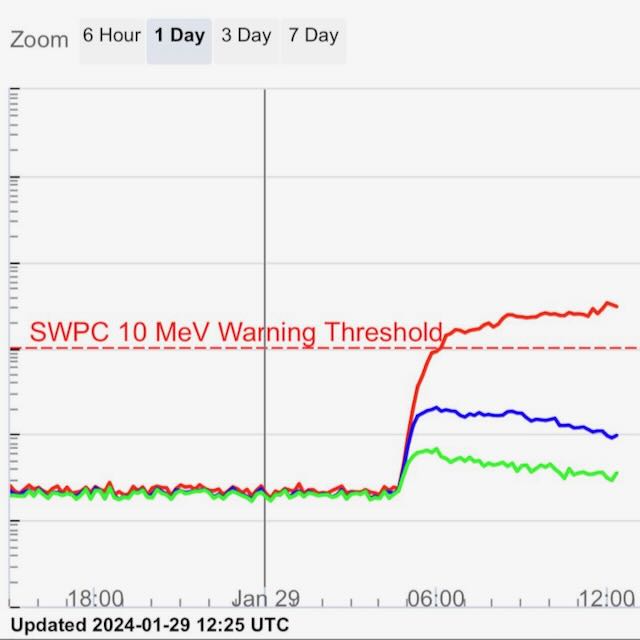
Sun news for January 28, 2024: Quiet Earth and quiet sun day
The EarthSky sun news team produced this video for you. Happy sun day!
We have hit another solar lull. It’s a quiet sun day, with just three visible sunspot regions on the sun’s Earth-facing side, two on the west limb (edge) and one on the east limb. Flaring levels and quantities are low, and the probability of flaring has decreased. The past day isn’t the lowest sun activity we’ve seen. But it’s low, which is par for the course, one of the ups and downs of the 11-year solar cycle. In other words, the cycle as a whole is a big up-and-down. And there are also little ups-and-downs on shorter timescales within the bigger cycle. During the overall up time – near solar maximum as now – we can see wiggles of relative high and low over the scale of weeks. It’s not unlike the fluctuations you and I experience within earthly seasons. During the winter months, we might have a warm day. Related to the lull at the sun is a lull at Earth in geomagnetic activity. There are fewer solar eruptions, so there are fewer geomagnetic disturbances. As we have seen in the recent past, activity will pick up soon. Perhaps the regions on the far side – which we discussed yesterday – will bring in some action! Stay tuned.
Last 24 hours: Activity levels are low. The sun produced 14 C flares, the largest of which was a C2.3 flare from AR3559 on January 27 at 22:47 UTC. The Earth-facing solar disk is almost bare, with only three sunspot regions on the limbs (edges). Region AR3561, even though rotated over the limb (edge), is still producing flares though they are partially blocked by the sun and so larger than they seem. AR3559, the largest region currently on the sun, produced the most flares of the visible regions. It appears that some of the regions seen on the back side are getting close to the limb (edge) and producing flares. Two coronal holes have rotated into positions allowing their solar wind to reach Earth. This solar wind may induce some enhanced aurora in the next several days.

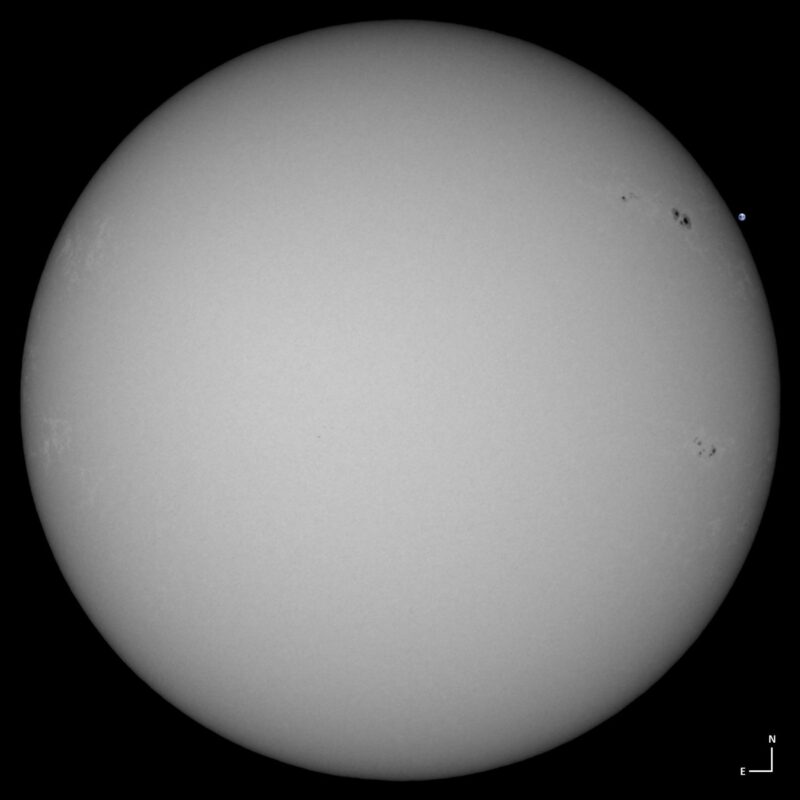
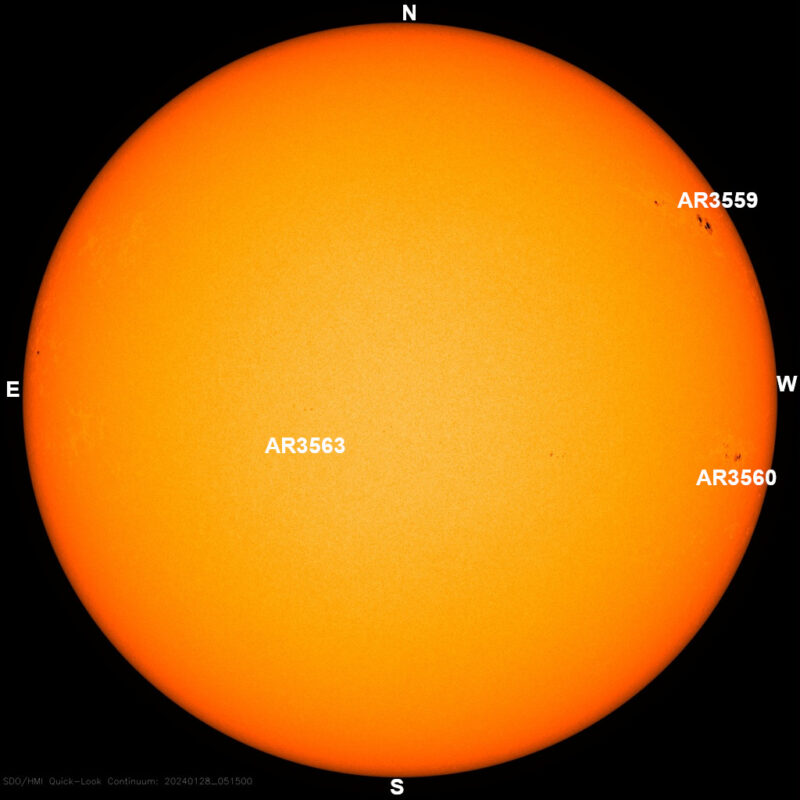
Sun news for January 27, 2024: Back-side action. Sunspots from Mars
The EarthSky sun news team produced this video for you. Thanks for watching!
Sun action now is on the far side. Over the past day, we saw a couple of large prominences – great arcs of solar material and magnetic fields – beyond the sun’s limb (edge), over the northwest and southeast quadrants. They might be the same active regions revealed indirectly via helioseismology – like seismology, studying the interior by observing surface vibrations – and seen directly by the Mars Perseverance rover. Yup, Mars is in our early morning sky now. But it’s still near our line of sight to the sun, looking at the side of the sun we can’t see. If these back-side active regions survive, we’ll see them rotate into view on the Earth-facing side of the sun in the next several days.
Last 24 hours: After being peppered with up to 13 numbered active regions on its Earth-facing side, today the sun shows an almost clear face with only faint sunspot regions. AR3559 kept its beta-gamma magnetic complexity and is the largest in area and extent. AR3561 is still sending up flares from beyond the solar horizon, but the rest of the labeled active regions remain stable with no flaring. The last day’s observation period between 11 UTC yesterday and 11 UTC today showed fewer and smaller flares than the day before. We observed nine C flares. The largest was a C3.0 flare from an unnumbered region in the southwest at 20:24 UTC on January 26. Despite being over the limb (edge), most of today’s flaring came from AR3561. Also, because AR3561 is around the edge of the sun, the flares are probably even larger than what we measure. We’ve been following a couple of coronal holes. The one located in the south is now centered and geoeffectively positioned. That means in a couple of days we may start receiving the fast solar wind it produces. The one located in the north is not directly in line with Earth, but some of its fast solar solar wind could still reach Earth. The sun currently has four labeled active sunspot regions. There is a newcomer today on the solar disk now labeled AR3563.
Sun news for January 26, 2024: Bye-bye sunspot region AR3561
Farewell, AR3561. The region that gave us ten M flares in a single day has left the building – or, at least, rotated out of view. It departs with still more to give, with its beta-gamma magnetic complexity indicating a good potential for more M and even X flares. However, this is a good time to mention that correctly determining the complexity of a region on the edge of the sun is very difficult. This type of magnetic field measurement only really works when viewing a region from above. Also, if the sunspot group does produce any big flares, they’ll now be partially blocked by the horizon, so they’ll appear smaller than they actually are. AR3561’s heyday is sadly over!
Last 24 hours: We are still waiting for possible coronal mass ejection (CME) impacts and the resulting geomagnetic storms and auroras. This possibility is decreasing as time passes. Sun activity is back to low, with only C flares produced over the past day. Between 11 UTC yesterday and 11 UTC today 10 Cs were fired, including six from departing region AR3561. The region produced two C9.0 flares, which were the largest flares of the period. The first came at 0:33 UTC and the second at 4:59 UTC, both on January 26. We’re continuing to watch the new large coronal holes as they rotate west. As they move into geoeffective positions, their fast solar wind could increase the chances for auroral displays. The sun currently has five labeled active regions.
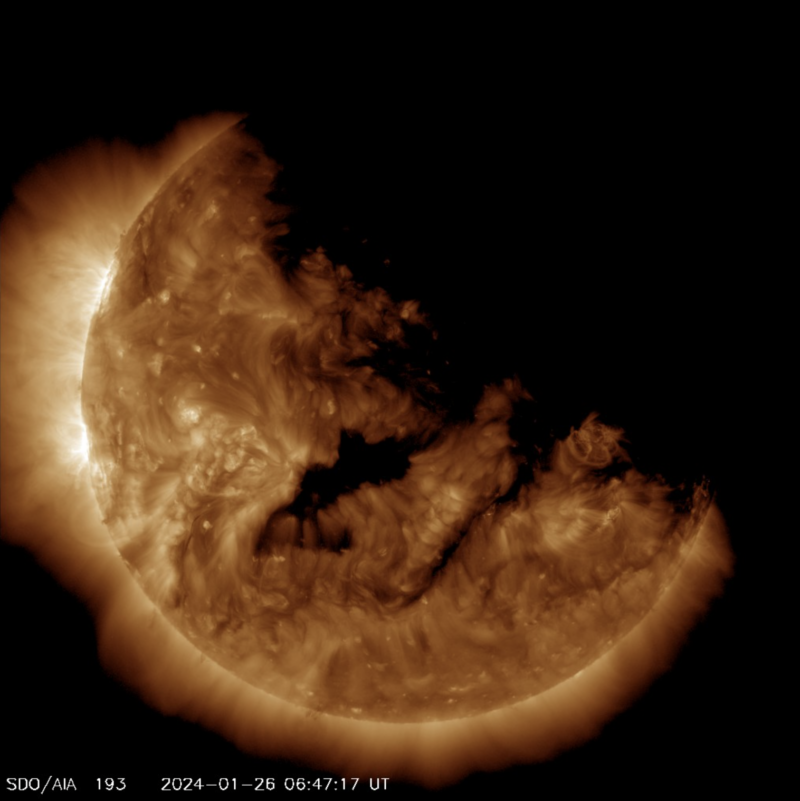
Sun news for January 25, 2024: Awaiting auroras
The EarthSky sun news team produced this video for you. Thanks for watching!
The expected geomagnetic storm didn’t arrive last night, and we’re still awaiting the arrival of several coronal mass ejections (CMEs) fired between January 22 and 23. The potential resulting G1 (minor) geomagnetic storm would mean auroras for northern latitudes, so stay tuned. On the sun, sunspot region AR3561 remains the center of attention, but its output has dropped from 10 M flares to just the one in the past 24 hours. It has retained its beta-gamma magnetic complexity, indicating the potential for more M and even X flares, but it better act fast – it will soon rotate out of view on the western limb (edge). However, AR3559 – which also has a beta-gamma complexity – has only just passed the center of the solar disk, so it’s got plenty of time to give us a show. Plus, scientists using helioseismology have detected two large sunspot regions on the far side of the sun, so even more action could be on the way.
Last 24 hours: Sun activity remains moderate, but flare production between 11 UTC yesterday and 11 UTC today decreased to 13 flares: one M and 12 C flares. This is a substantial decrease from the previous day, which saw 24 flares including 11 Ms. The past day’s single M flare, an M1.3, came from AR3561 at 20:58 UTC on January 24. The flare caused an R1 (minor) radio blackout over the South Pacific Ocean. AR3561 was again the leading flare producer, firing ten of the 13 flares. The Earth-facing solar disk currently has six numbered sunspot regions. There are a couple new large coronal holes that we have been observing since yesterday, one in the northeast and the other in the southeast. Their fast solar wind may enhance auroral displays when the holes move into geoeffective positions.
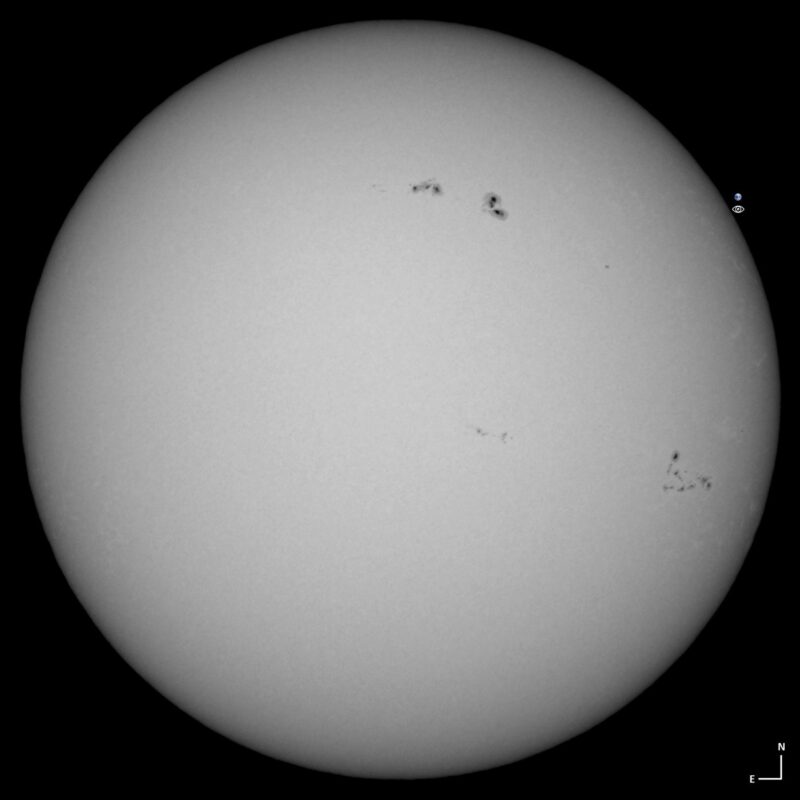
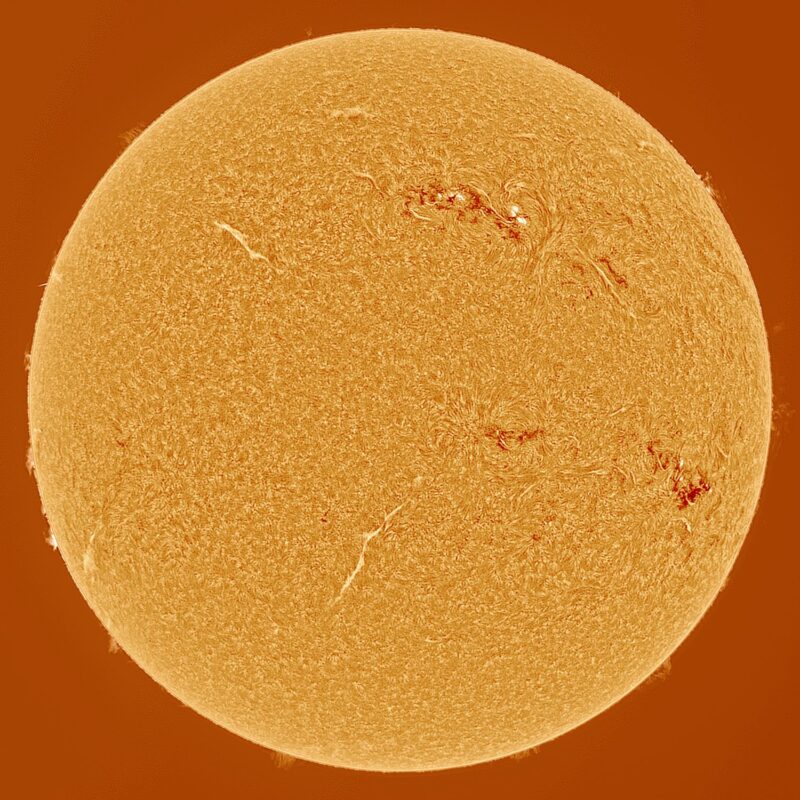
Sun news for January 24, 2024: Busy sunspot region AR3561
The EarthSky sun news team produced this video for you. Thanks for watching!
Today our attention has been grabbed by sunspot group AR3561. This group displayed some intense activity over the past day, blasting 10 of the day’s 11 M flares, as well as 7 C flares. We also saw the active region gain several sunspots and develop a beta-gamma magnetic complexity, which means it has an increased potential for more C, M, and maybe even X flares. We’ll have to keep an eye on this region. As a result of AR3561’s activity, multiple coronal mass ejections (CMEs) are expected to reach Earth during the next day. That means possible auroral displays! Good luck, aurora hunters, and please share your photos with us.
Last 24 hours: Today’s sun activity is moderate after the production of 11 M flares. Between 11 UTC yesterday and 11 UTC today, we saw an additional 12 Cs for a total of 23 flares. The lead flare producer was sunspot region AR3561 with 17 flares: 10 Ms and 7 Cs. The largest flare was an M4.3 from AR3561 at 16:40 UTC on January 23. Shortly after the flare an R1 (minor) radio blackout affected an area over Chile.
Here’s a list of the M flares fired over the past 24 hours (all times UTC):
M1.0 by AR3561 at 12:58 on January 23 – R1 (minor) radio blackout over the middle of the South Atlantic Ocean,
M1.0 by an unnumbered region in the northeast at 13:08 UTC – R1 radio blackout over the South Atlantic Ocean,
M1.3 by AR3561 at 14:59 on January 23 – R1 radio blackout over the east coast of Brazil,
M4.3 by AR3561 at 16:40 on January 23 – R1 radio blackout over Chile,
M1.0 by AR3561 at 18:28 on January 23 – R1 radio blackout off the west coast of Chile,
M1.1 by AR3561 at 18:44 on January 23 – R1 radio blackout over the South Pacific Ocean,
M1.0 by AR3561 at 19:52 on January 23 – R1 radio blackout over Easter Island,
M1.0 by AR3561 at 20:01 on January 23 – R1 radio blackout over Easter Island,
M1.1 by AR3561 at 00:38 on January 23 – R1 radio blackout over Fiji,
M2.7 by AR3561 at 1:40 on January 24 – R1 radio blackout over the northeast coast of Australia,
M1.4 by AR3561 at 5:43 on January 24 – R1 radio blackout over the South Indian Ocean.
The Earth-facing solar disk currently has seven numbered sunspot regions.

Sun news for January 23, 2024: What a day! Huge flare increase and multiple CMEs
The EarthSky sun news team produced this video for you. Thanks for watching!
What a day of solar activity! Over the past day we saw increase in the number of flares, an increase in flare intensity, an M5.1 flare (that’s halfway to an X flare), and a filament eruption that produced an Earthbound coronal mass ejection (CME). You name it, we saw it! And to top it off, we’re anticipating a geomagnetic storm with possible auroral displays tonight. After more than a week-long lull, the sun is back to showing the behaviour we’d expect from a star on its way to solar maximum.
Last 24 hours: Today’s sun activity is high after the production of an M5.1 flare. Between 11 UTC yesterday and 11 UTC today, we saw 9 M flares and 17 Cs for a total of 26 flares, a marked increase in flare quantity and intensity compared to the previous day. The lead flare producer was sunspot region AR3561 with 23 flares: 7 Ms and 16 Cs. The largest flare, an M5.1, was fired by AR3559 at 3:31 UTC on January 23. A corresponding R2 (moderate) radio blackout occurred over Australia. Here’s a breakdown of all the M flares fired over the past 24 hours (all times UTC):
M1.1 by AR3559 at 19:24 on January 22 – R1 (minor) radio blackout over the South Pacific Ocean.
M1.3 by AR3561 at 19:32 on January 22 – R1 radio blackout over the South Pacific Ocean.
M2.0 by AR3561 at 19:47 on January 22 – R1 radio blackout over the South Pacific Ocean.
M3.4 by AR3561 at 21:21 on January 22 – R1 radio blackout over Fiji.
M1.6 by AR3561 at 21:43 on January 22 – R1 radio blackout over Fiji.
M2.1 by AR3561 at 22:22 on January 22 – R1 radio blackout off the northeast cost of Australia.
M5.1 by AR3559 at 3:31 on January 23 – R2 (moderate) radio blackout over Australia.
M2.4 by AR3561 at 8:22 on January 23 – R1 radio blackout over the east coast of Madagascar.
M2.4 by AR3561 at 9:30 on January 23 – R1 radio blackout over the east coast of Madagascar.
The Earth-facing solar disk currently has seven numbered sunspot regions.
Sun news for January 22, 2024: Twofer! Aurora tonight. Sun flares up!
The EarthSky sun news team produced this video for you. Thanks for watching!This week is starting off with excitement! We anticipate auroral displays at Earth tonight … and, following last week’s lull, solar flaring picked up over the past day. A coronal mass ejection (CME) from January 20 is expected to strike Earth’s atmosphere and magnetosphere later today. It means we might see auroral displays down to the northern U.S. states and northern Europe. The geomagnetic storming should begin late today (in UTC) and extend through early tomorrow. If you’re at a northerly (or southerly) latitude, tonight is a good time to pull out your warm clothing for a possible nighttime spectacle. Consider sharing your aurora through the EarthSky photo community. Meanwhile, on the sun itself, sunspot region, AR3559, has grown in size and complexity over the past day. It tripled in size over the weekend! And it’s brought with it increased flaring, so that sun activity today risen from last week’s “low” to “moderate.” This sunspot region produced 13 of the 19 flares in the past day, including one M flare. And here’s a plus! Anyone with eclipse glasses or a solar projector has a chance to see sunspots today. AR3559 is the size of more than two Earths. It can be seen without magnification. Whether you’re a daytime viewer, or nighttime viewer … clear skies to you all!
Last 24 hours: Today’s sun activity is moderate. We had 18 C flares and 1 M flare between 11 UTC yesterday and 11 UTC today. The largest was an M1.5 from AR3559 at 6:09 UT on January 22. Regions AR3559, 3560, 3561, and AR3562 experienced growth. AR3559 experience the most growth and change, tripling in size over the weekend and developing a beta-gamma region showing an increased chance for M and X flares. The Earth-facing solar disk has eight numbered sunspot regions.
Sun news for January 21, 2024: CME on its way. Aurora expected!
Sun news January 21. The EarthSky sun news team created this video for you. Thanks for watching!
The coronal mass ejection (CME) from yesterday’s on-disk filament eruption is on its way to Earth. The CME may have several parts spreading out the impact from mid-to-late January 22. Both NASA and NOAA expect the impact to start sometime around 11 to 13 UTC on January 22. First the initial shock … then the bulk of the impact should arrive. So the geomagnetic storming – and the aurora – are expected late January 22, and into early January 23. NASA is estimating G1 to G2 geomagnetic storms. Meanwhile, NOAA currently estimates a G1 storm. Aurora may be seen in U.S. states as far south as Iowa, Washington, Illinois, New York, and in Europe as far south as Denmark, the United Kingdom, the Netherlands, and Poland. Aurora in the southern hemisphere may be seen as far north as New Zealand and Tasmania. Clear skies and good luck, aurora-watchers!
Last 24 hours: Today’s sun activity is still low, albeit with an increase in flares. We had 16 C flares and 1 B flare between 11 UTC yesterday and 11 UTC today. The largest was a C6.3 from AR3559 at 1:57 UT. The region continues as the top flare producer with the most events at 13 of the 17 flares. Regions AR3559, 3560, and 3561 all experienced growth and a new region, AR3562, emerged in the southwest. A filament just below AR3559 erupted around 1:30 UTC on January 21, 2024. It appears to be to the sun’s east, away from Earth, but we await further analysis. The Earth-facing solar disk has nine numbered sunspot regions.

Sun news for January 20, 2024: Double blast from the sun
Sun news January 20. The EarthSky sun team produced this video for you. Thanks for watching!
The sun released two massive, nearly simultaneous ropes of solar plasma earlier today (around 8:40 UTC on January 20). Both are in the east, one from the eastern limb (edge) and the other just to the west of it on the solar disk. Both giant ropes of sun stuff are called erupting filaments. But – because of its location – we typically call the one on the solar limb an erupting prominence. Prominences and filaments are the same thing! But we see them differently. And so this different naming is historical. At one time, scientists thought these two type of events were different. Now, we realize we just see them them from different perspectives. But the name prominence stuck. Now, it just means a filament seen on the limb with space behind it. Neither eruption had notable flares associated with them. But both produced coronal mass ejections (CMEs). Given their locations, the CMEs most likely don’t have Earth-directed components. But more imagery is needed to make a more confident determination. By the way, these two events happened as – from the perspective of the Solar Dynamics Observatory (SDO) – the sun was just emerging from behind the Earth. Yes, we’re now in SDO’s eclipse season, which will last through February 10.
Last 24 hours: Today’s sun activity continues at low levels. During the past day, the sun’s flaring consisted of only C and B flares. Between 11 UTC yesterday and 11 UTC today, the sun produced six C and four B flares. The largest was a C3.5 flare from an unnumbered incoming active region in the southeast at 9:34 UTC on January 20. The top flare producer was active region AR3559 with a C and three Bs during the period. The numbered regions had either alpha or beta magnetic complexity. There are nine numbered sunspot regions. A newcomer, AR3561, emerged near disk center.
Sun news for January 19, 2024: Today’s date on the sun in 2005, surprise!
Sun news January 19. The EarthSky sun team produced this video for you. Thanks for watching!
Today we’re looking back 19 years – to January 19, 2005 – and the days around it. It was two to three years after a Solar Max, and it’d been a quiet time on the sun, a lull, much like we’ve experienced this week. But the sun surprised us! Starting around January 10, 2005, a little sunspot emerged near the sun’s northeast limb. Over the next two days, it grew to a massive region the size of our solar system’s largest planet, Jupiter. And it kept its size as it crossed the sun’s Earth-facing side. Over that time, starting on January 12, 2005, we quickly went from small C flares (relatively weak flares) to many M (moderate) flares. And, by January 15, 2005, we’d seen a total of four X flares, or very strong flares! By January 20, 2005, we’d seen many more M flares and a total of six X flares. The final X flare – on January 20, 2005 – was an X10! That’s a big, big flare on the sun. In today’s video, you can watch the sunspot region grow rapidly. Next, the flare X-ray monitor shows the fast rise from C, to M, to X before things calm back down once the region rotates out of view. By the way … we didn’t have the mighty sun-observing SDO spacecraft then. But we had its predecessor, SOHO, which gave us a similar view. In the video, the flares are visible in the Extreme-ultraviolet Imaging Telescope (EIT) aboard SOHO. Several of the events produced particle storms apparent as a sudden burst on snow on the images. During this period, the associated coronal mass ejections (CMEs) from the M and X flares produced numerous geomagnetic storms at Earth including strong G4 storms on January 19 and 22, 2005. Stay tuned to see if the sun has anything like this in store.
Last 24 hours: Today’s sun activity is low with seven C flares between 11 UTC yesterday and 11 UTC today. That’s in contrast to yesterday’s 15 C flares. The largest event was a C2.3 from active region AR3553 at 12:28 UTC on January 18. This region was the top producer, with three C flares. AR3555 lost its promising beta-gamma magnetic complexity. Today, we see only alpha and beta active regions. So, indeed, we’re in a lull! But our star always has something happening. During the past day, we saw a beautiful prominence lifting plasma into space. The event occurred at around 12:18 UTC on January 18 on the sun’s northeast limb (edge).
The action appears to be on the far side of our star, as we see long-lasting prominences and jet-like explosions on the limb (edge) of the solar north pole and southwest. Meanwhile, the Earth-facing sun has eight labeled active regions today.
Sun news for January 18, 2024: Weird-looking SDO calibrations
Sun news January 18. EarthSky sun post co-author C. Alex Young – a solar astrophysicist at NASA Goddard Spaceflight Center – also produces @thesuntoday.
Today we focus on the Solar Dynamics Observatory (SDO), one of the most important spacecraft observing the sun. As with the past two days, SDO experienced another day of eclipses, with the Earth briefly obscuring its view of our star. But we also saw some strange shifting in the images – up and down, then right and left. This wasn’t a malfunction; these shifts are actually used to calibrate or fine-tune the cameras on the spacecraft. Calibrations like this one are performed regularly to ensure observations remain consistent over time. Let’s hope the newly calibrated instruments capture an increase in solar action in the coming days!
Last 24 hours: Sun activity remains low, with only 15 C flares produced between 11 UTC yesterday and 11 UTC today. However, this was an increase compared to the ten C flares produced the previous day. The largest of all the flares was a C5.4 that sunspot region AR3553 released at 4:08 UTC this morning. This region was the leading producer of the day with six C flares. Meanwhile, AR3555 developed a promising beta-gamma magnetic complexity, indicating a potential for larger flares. The Earth-facing side of the sun today is populated with nine labeled active regions.
Sun news for January 17, 2024: Signs of an active sun. Plus, more Earth eclipses today
Sun news for January 17. The EarthSky sun team created this video for you. Thanks for watching!Solar maximum is on its way, possibly in 2024, and in the past day the sun has shown multiple signs that it’s reaching its peak activity. These include a lot of active filaments, many active sunspot regions, and instances of coronal rain. And at this writing (11 UTC on January 17), the solar disk is peppered with sunspot regions and active filaments, and the limb (edge) is covered with prominences, many of which are firing out plasma that’s falling back to the surface. One sign of an active sun that we don’t have: we don’t have high levels of flaring. But that can change in an instant! By the way, we’re now in the SDO eclipse season. Every day until February 10, SDO’s view of the sun will be briefly blocked by the Earth. Check out this beautiful spectacle in the images below.
Last 24 hours: Ten C flares were produced between 11 UTC yesterday and 11 UTC today, amounting to low activity. The largest was a C2.7 flare, fired at 7:24 UTC on January 17 by an incoming active region in the northeast. This as-yet-unnumbered region was the lead flare producer of the day, with three C flares since its appearance. The sun currently has ten labeled active regions. Most of these have simple, low-potential alpha or beta magnetic configurations and have remained stable with low activity. The largest in size are AR3549 and AR3545, which can be spotted from the ground without any magnification if you wear the proper eye protection.
Sun news for January 16, 2024: Huge prominence, and more action incoming
Last night we saw a huge prominence erupt from around the solar south pole. This rope of plasma and magnetic fields came from the far side of our star, and measured at least 200 Earths long! The GOES-16 spacecraft observed it at around 22:04 UTC on January 15, and the SOHO spacecraft detected a corresponding coronal mass ejection (CME) at 0:12 UTC this morning. We also saw long-lasting prominences on the east limb, where activity remains strong. This indicates that activity is coming our way from the east, but it has not yet rotated onto the Earth-facing solar disk. Stay tuned.
Last 24 hours: Only seven C flares were produced between 11 UTC yesterday and 11 UTC today, making sun activity low. The largest was a C2.9 flare by sunspot region AR3553 in the northeast at 14:05 UTC on January 15. AR3541 produced the three C flares, the most of the day. The sun currently has eight labeled active regions, including an as-yet-unnumbered newcomer on the northeast limb (edge). As mentioned yesterday, the Solar Dynamics Observatory (SDO) began its eclipse season today at around 7:15 UTC – check out the images below.

Sun news for January 15, 2024: SDO’s eclipse season starts tomorrow
Sun news January 15. Eclipses of the sun by the Earth and moon! The EarthSky sun team produced this video.
It was another calm day on the sun, only interrupted by Earth! Because of the particular orbit of the Solar Dynamics Observatory (SDO) orbit around Earth, sometimes Earth blocks the sun from the spacecraft’s point of view. Solar scientists speak of SDO’s eclipse seasons for the several-week period – twice each year – when these events regularly occur. Those seasons used to come in spring and fall. But they’ve shifted; now they’re coming winter and summer. The next SDO eclipse season starts tomorrow (January 16, 2024) and ends on February 10. During the coming weeks, Earth might block the sun, as seen from SDO, for minutes to just over an hour. Plus, the moon sometimes eclipses the sun as seen from SDO, too. Unlike the moon, Earth has an atmosphere, so when Earth passes between SDO and the sun, we see a fuzzy edge, not a nice sharp edge as during lunar transits. Again, we’re not quite in an official SDO eclipse season today. The regular season starts tomorrow. But Earth did slightly block the sun today as seen from SDO, as shown in the video at top. P.S. The summer eclipse season will be July 15 – August 11, 2024.
Last 24 hours: In terms of flares, sun activity is low. From 11 UTC yesterday to 11 UTC today, we saw 12 C flares. The largest was a C9.6 (nearly an M flare) at 11:30 UTC on January 14, from AR3543. This region is just over the northwestern limb (edge) indicating the flare was partially occulted and so, in reality, was probably at least an M1. The relative calm continues with some average activity, such as coronal rain (discussed yesterday), some small filament eruptions, and minor flares.
Sun news for January 14, 2024: It’s a rainy sun day
Sun news January 14 … rain on the sun! The EarthSky sun team produced this video. Thanks for watching!
Happy sun day! It’s a day of rest for many, and that also goes for the sun. But despite a flaring calm and overall low sun activity, there’s always excitement on our local star. How about rain? Yes, it rains on the sun often, in the form of raining plasma, or super-hot gas. Million-degree-plus plasmas rise from lower down in the solar atmosphere, then cool to a mere 40,000–80,000 degrees. Condensation occurs, high up in the sun’s corona or outer atmosphere. Because the gas is superheated – a plasma – it’s also magnetized. So when it condenses and falls, it follows the magnetic fields extending up from the sun’s visible surface, from sunspots. This all makes the plasma appear to come from nowhere and follow curves (a curved magnetic field line), falling back down to the sun’s lower atmosphere. It happens most often when – as now – the sun is near the peak of its 11-year cycle. Scientists have dubbed this solar plasma condensation process as coronal rain.
Last 24 hours: The Earth-facing area is still covered with 12 sunspot regions. Despite the number of active regions, sun activity due to flaring is still low. The sun produced 11 C flares, the largest being a C4.2 at 00:12 UTC on January 14, 2024, from AR3536. AR3541 produced five of the 11 flares, the most productive region. Regions on the eastern limb (edge) appear to be the source of the coronal rain and should soon be rotating into view. There is quite a show of dynamic processes around the limb, including a large eruption just over the northwestern limb.
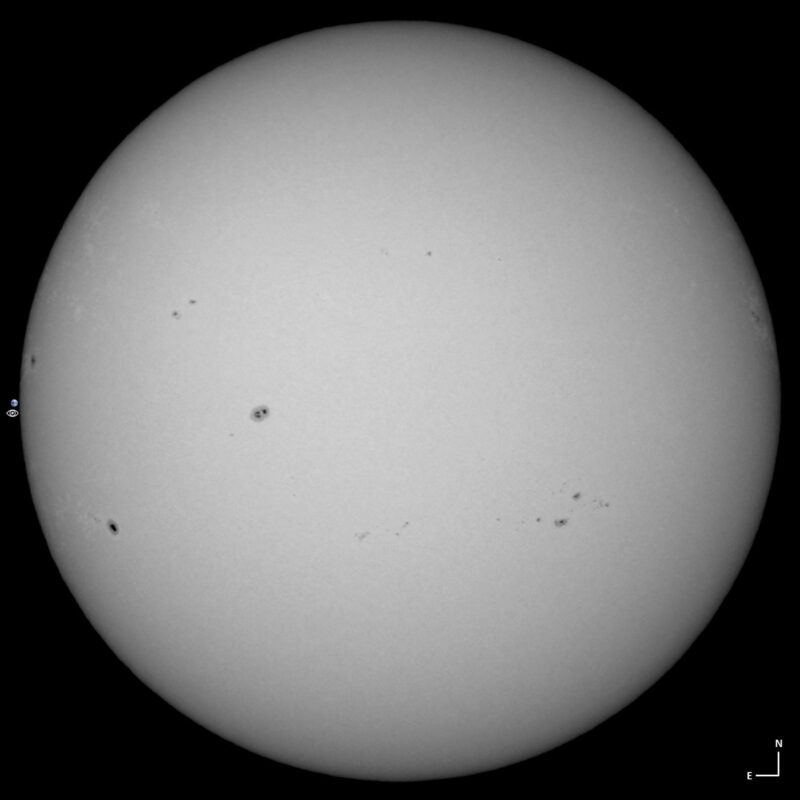


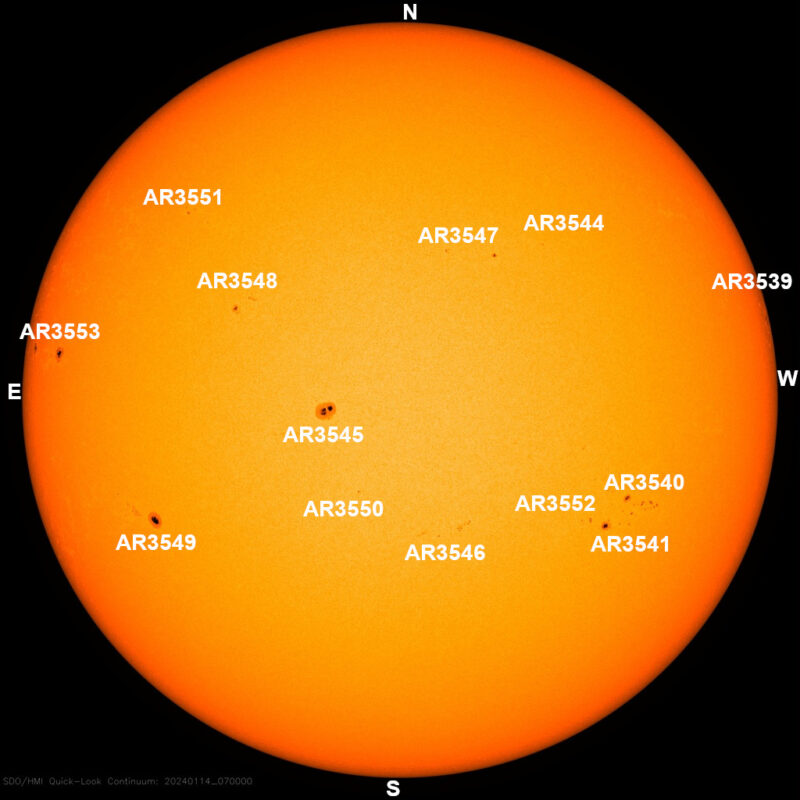
Sun news for January 13, 2024: A mighty 12 sunspot regions today
Sun new January 13. A mighty 12 sunspots today, most since June of 2023.
With Solar Max – the peak of the sun’s 11-year cycle – expected this year, even a so-called calm sun has a lot going on. Sun activity is back to low with only C flares during our observation period from 11 UTC yesterday to 11 UTC today. Yet the sun has 12 active regions on its Earth-facing side. This is the highest number of active regions so far this year. We haven’t seen this many active regions on the sun since June 2023, when there were 16 labeled regions. This is just another sign that Solar Max is on its way.
Last 24 hours: Today’s Earth-facing side of the sun may already be speckled with active regions, but more are on the way according to helioseismology. Plus, we can see some dynamic jet and prominence activity from over the eastern limb. Something strong is coming. The sun produced 15 C flares over the past day, with the largest being a C4.8 flare from active region AR3538 at 17:22 UTC on January 12. Given that AR3538 has already rotated mostly out of view, it may have been larger. The lead flare producer was active region AR3539 with three flares. The sun has 12 active regions on its Earth-facing side; four of them are newcomers: AR3548, AR3549, AR3550, and AR3551.
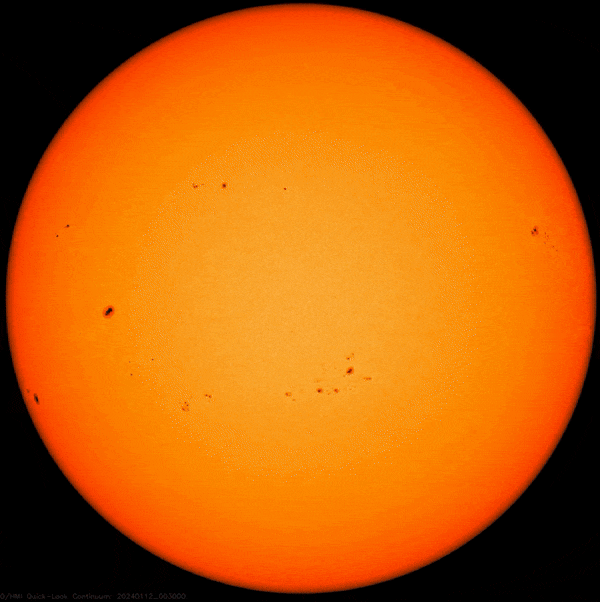

Sun news for January 12, 2024: 4 M flares on the road to Solar Max!
Sun news January 12. The EarthSky sun news team produced this video. Thanks for watching!
Solar Max – the peak of the sun’s 11-year cycle – is expected in 2024. From 11 UTC yesterday to 11 UTC today the sun produced four M flares! Take a look at the breakdown below. Worth mentioning is active region AR3538, producer of two M flares the day before yesterday, and lead flare producer over the past day as well. The sun’s rotation is now carrying it out of view, on the northwest limb. Its departure is making the northwest portion of the sun look fiery! In the meantime, more action seems to be coming our way. The east limb looks very active, too, from just around the corner to the far side, the side we don’t normally see from Earth. As the sun rotates, these regions from the far side will soon come into view. Stay with us for more sun news.
Last 24 hours: Sun activity is now moderate. The sun produced four M flares over the past day. Between 11 UTC yesterday to 11 UTC today, the sun’s flaring production was 20 flares in total: four Ms and 16 Cs. The largest was an M1.4 blasted by departing active region AR3538 at 12:51 UTC on January 11. Each one of the M flares caused an R1 (minor) radio blackout. Here’s a breakdown of the Ms:
1. M1.4 by AR3538 at 12:51 UTC on January 11. R1 (minor) radio blackout over mid-South Atlantic Ocean.
2. M1.5 by AR3539 at 17:52 UTC on January 11, the largest. R1 (minor) radio blackout over South Pacific Ocean off west coast of Chile.
3. M1.2 by AR3538 at 19:23 UTC on January 11. R1 (minor) radio blackout over South Pacific Ocean over Easter Island.
4. M1.1 by AR3547 at 2:58 UTC on January 12. R1 (minor) radio blackout over Australia.
Lead flare producer was active region AR3538, which blasted out seven total flares, the two Ms included. It was closely followed by AR3539, producer of six flares, the largest M of the period included. The sun now has nine labeled active regions on its Earth-facing side. There is a newcomer on the northeast quadrant, now numbered AR3547.
Sun news for January 11, 2024: Moderate with 2 M flares.
The active sun is continuing its diverse action across the disk. The past day saw two M flares, bringing activity to moderate levels. An M1.9 came from AR3538 over the west limb, and an M1.4 came from an as-yet unnumbered source on the southeast limb. Two spectacular filament eruptions came from the east, first with one on the east limb in a spectacular fan and a liftoff from the eastern quadrant.
Last 24 hours: Sun activity is moderate due to two M flares. Between 11 UTC yesterday to 11 UTC today, the sun produced 20 flares: two Ms and 18 Cs. The largest was flare an M1.9 from AR3538 at 23:28 UTC on January 11. The other M flare was an M1.4 at 12:55 UTC, January 10, from an unnumbered active region incoming on the southeast limb (edge). The M flares caused R1 (minor) radio blackouts. The M1.4 radio blackout affected an area over the South Atlantic Ocean, and the M1.9 radio blackout affected an area over French Polynesia in the South Pacific Ocean. AR3539 was the lead flare producer with seven C flares. The sun has nine labeled active regions on its Earth-facing side.
Sun news for January 10, 2024: The calm has ended, activity on the rise
The EarthSky sun news team produced this video. Thanks for watching!
The sun’s calm day is ending. Flare size, flare number, and prominence/ filament activity all have picked up over the past 24 hours. Our top-producing region, AR3538, even blasted out an almost-M flare, a C9.6. A hair below M! The sun has 10 sunspot regions on its Earth-facing side today. And more from the sun’s far side may rotate into view soon. The big flare producer from the beginning of the year, AR3536, has maintained its beta-gamma magnetic complexity. That means it still harbors the potential for M or X flares. These are all more signs that the current solar cycle – Cycle 25 – is reaching its peak, aka Solar Maximum. The excitement should continue. The question remains: how big will the activity get? Stay tuned!
Last 24 hours: Sun activity is low, but just barely. The sun produced 19 C flares over the past day (11 UTC yesterday to 11 UTC today). The largest flare was a C9.6 flare from active region AR3538 at 3:35 UTC on January 10. This almost-M flare was just shy of alert levels, but it did produce a small radio blackout over Australia. This region continues to be the top flare producer, with nine of the 19 flares. The sun currently has 10 numbered active regions on its Earth-facing side. Two of them are newcomers: AR3545 on the southeast limb (edge), close to the solar equator, and AR3546 on the southeast quadrant, east of AR3541. Only sunspot region AR3536, the X5 flare producer, kept its beta-gamma magnetic complexities, but it’s got the potential for more.

Sun news for January 9, 2024: A calm sun near Solar Max
A calm day on an active sun is wayyyyyy more dynamic than a busy day on a quiet sun! See the images above? Although we’re nearing the peak of the current solar cycle, today’s sun is calm, with no significant flares or eruptions. But just over a week ago, on New Year’s Eve, we saw an X5 flare, the most powerful flare of this solar cycle so far. What gives? While the sun will, on average, be much more active around solar maximum, it still exhibits periods of calm between bursts of activity. The sun’s calm at Solar Max is relative. It’s the calm before a storm. Stay tuned to see what our sun has in store.
Last 24 hours: Sun activity remains low. It produced 16 C flares over the past day (11 UTC yesterday to 11 UTC today). The largest flare was a C5.7 from AR3538 at 15:50 UTC on January 8. This region was also the top flare producer, with 10 of the 16 flares. The sun currently has eight numbered active regions on its Earth-facing side. Two of them, AR3536 and AR3540, kept their beta-gamma magnetic complexities, meaning they have the most potential for powerful flares.
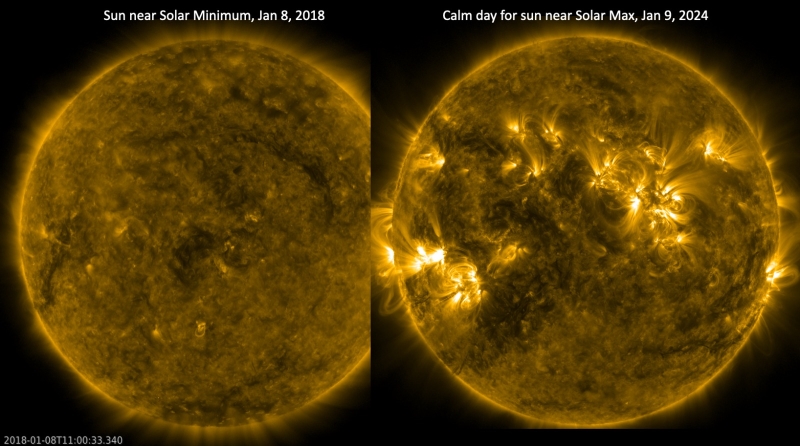
Sun news for January 8, 2024: Final flash from AR3534
It’s a quiet Monday on the sun. The largest flare was a C8.8, from AR3534. The sun’s rotation has now carried AR3534 just over the sun’s western limb (edge). Yet we know this sunspot region still has some oomph left in it, because the C8.8 flare must be a much-larger flare. Why? Because it’s beyond the sun’s visible edge now. So not all of the C8.8 flare was visible to us. It was partially occulted (blocked) by the sun. That’s why the flare appeared so bright in SDO images, but isn’t measured as larger on the GOES flare intensity scale. If we could have seen it directly, we’d have seen at least a small M flare.
Last 24 hours: Overall, sun activity is low. There are many visible sunspot regions now, with more on the way (see yesterday’s post, below). But we’re seeing C flares, with only two of them close to the M range. Over the past day (11 UTC yesterday to 11 UTC today), we have had 17 C flares. The largest flare was a C8.8 from AR3534 at 22:11 UTC on January 7, 2024. Of the nine sunspot groups facing Earth, three of them have beta-gamma magnetic complexity, meaning these regions have the most potential for flaring.
Sun news for January 7, 2024: We can see sunspots from Mars
Sun news for January 7, 2024. Sunspots from Mars! C. Alex Young and Deborah Byrd produced this video.
Here’s something fun. Using the MAST camera on the Mars Perseverance Rover, we can see sunspots on the sun’s far side. Normally, we can’t see the far side (although we do sometimes use helioseismology to learn about big sunspots there). Images from the Mars rover are small. But big-enough sunspot groups on the far side do show up in the Perseverance photos. Mars itself is on the far side of the sun from Earth now. So these solar images from Mars give a unique perspective, one we wouldn’t have otherwise, showing us sunspots we can’t see from Earth right now. Thanks, Perseverance!
Last 24 hours: Sun activity is low, but maybe not for long. Recent flares have been small in size, just B and C flares. But over the past day (11 UTC yesterday to 11 UTC today), there’ve been a lot of flares, 25 in the past 24 hours. That’s partly because there are a lot of sunspots currently facing Earth. And – as shown by the Mars rover Perseverance (see above) – there are a lot of them just around the corner. The largest flare on the near side in the past day was a C7.1 at 15:27 UTC on January 6 from active region AR3538. The region produced 12 of the 25 flares. The sun has seven numbered sunspot regions.
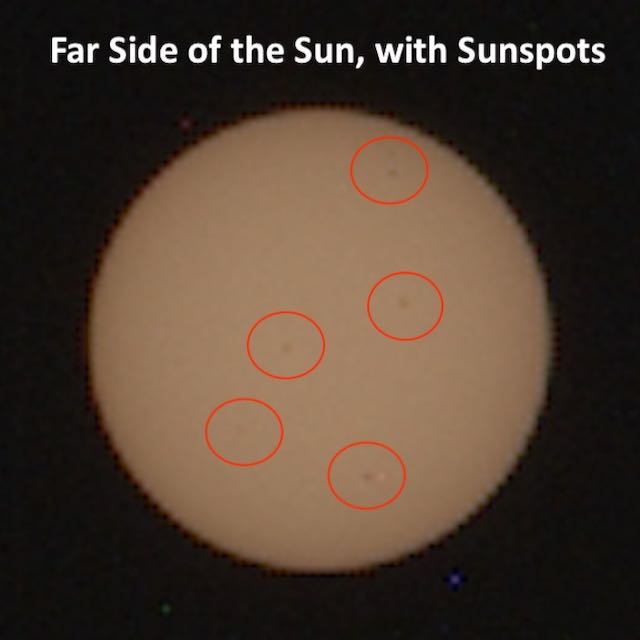
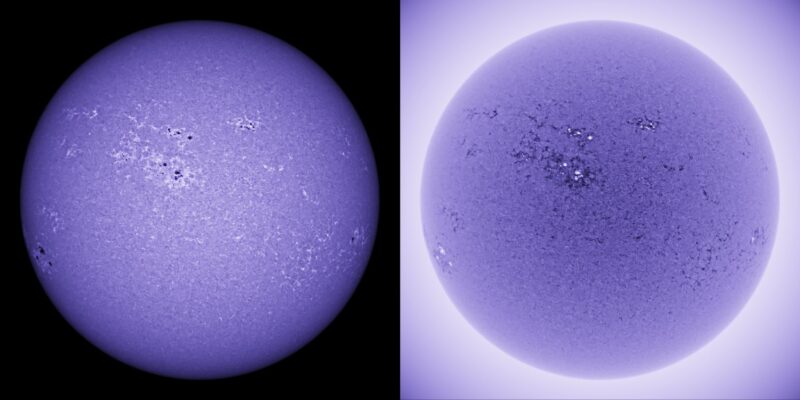

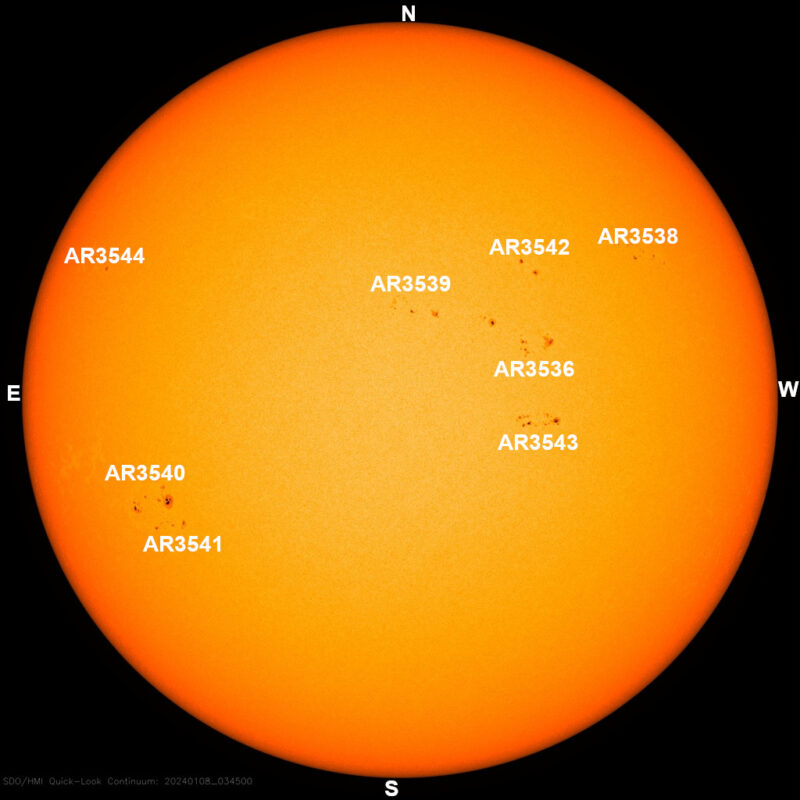
Sun news for January 6, 2024: Our hero of the week, AR3536
Sun news for January 6. The EarthSky sun team produced this video. Thanks for watching!
Sunspot region AR3536, now famous as the producer of the biggest X flare of the solar cycle so far – an X5 blasted on December 31 – is still going. It produced the most flares over the past day, albeit only C flares. And it’s been hurling ejecta into space all week. None has hit Earth so far, but in the coming day or two, this sunspot region will be geoeffectively positioned – capable of affecting Earth – perhaps promising auroral displays. Plus, among today’s six labeled active regions, AR3536 is the only one bearing a beta-gamma configuration, the rest showing only alpha or beta. That means, at any minute, this former X-flare producer might give us a surprise, since its magnetic complexity can yield more Cs, Ms and even another X flare. Keep tuned.
Last 24 hours: Sun activity continues to be low. The sun produced only C flares in the past day. Between 11 UTC yesterday and 11 UTC today, it blasted 11 flares. The largest was a C5.2 at 4:50 UTC on January 6, not from AR3536 as you might expect, but from active region AR3538 in the sun’s northwest. So AR3536 produced five flares, AR3540 (a newcomer) produced four flares, and AR3538 produced two flares during our observation period. The sun currently has six numbered sunspot regions on its Earth-facing side. The two newcomers we mentioned yesterday are now numbered AR3540 and AR3541.
Sun news for January 5, 2024: Sunspot region AR3536 hurling ejecta into space
The amazing active region AR3536 – which, on New Year’s Eve, produced the biggest X flare so far of Solar Cycle 25, plus several M flares after that – has calmed down and has lost some of its magnetic complexity. It spent the past 24 hours hurling ejecta into space. Its plasma ejections finally exploded into a gorgeous prominence at around 1:50 UTC this morning (January 5). These events of the past day are under further analysis and modeling by specialists to determine if there is an Earth-directed coronal mass ejection, or CME.
Last 24 hours: Overall, sun activity is back to low, with only C flares in the past day. Between 11 UTC yesterday and 11 UTC today, the sun produced 17 flares in total. The largest was a C3.7 flare from AR3534 on the sun’s southwest quadrant, which exploded at 8:09 UTC this morning (January 5). The lead flare producer of the period was a newcomer active region – as yet unnumbered – on the sun’s southeast limb (edge). It blasted seven C flares. Three other regions offered three C flares each: AR3536, AR3534, and an unnumbered newcomer on the northeast. The sun currently has four numbered sunspot regions on its Earth-facing side.

Sun news for January 4, 2024: Sunspot region AR3536 is going strong
Today’s sun news video was produced by C. Alex Young, Raúl Cortés and Deborah Byrd. Thanks for watching!
Recent X flare producer AR3536 has maintained its promising flare activity, releasing back-to-back M flares early this morning. The largest of the two, an M3.9 flare, produced a fast jet of plasma and a coronal mass ejection (CME). We await further analysis to see if the CME has an Earth-directed component. AR3536 is currently rotating toward a more geoeffective position, meaning it will soon be in a prime position to send CMEs toward Earth. This, combined with the region’s continued activity, size, and magnetic complexity, means AR3536 still deserves a lot of attention. Why not give it some yourself; wearing the proper eye protection, the region is big enough to be seen from Earth without any magnification!
Last 24 hours: Sun activity remains moderate. Between 11 UTC yesterday and 11 UTC today, the sun produced 17 flares: 15 Cs and two Ms. Both M flares came from AR3536 on January 4. The first was an M1.1 flare at 1:16 UTC, followed by an M3.9 flare at 1:55 UTC. Shortly after each flare, R1 (minor) radio blackouts occurred over the South Pacific Ocean off the Australian northeast coast. Producing seven flares over the past day, AR3536 remains the lead flare producer. It’s also still the largest and most magnetically complex, keeping its beta-gamma configuration. That means it still has a good chance of producing large M flares or even another X flare. The sun currently has four numbered sunspot regions on its Earth-facing side.

Sun news for January 3, 2024: Keeping an eye on sunspot region AR3536
Sun news January 3, 2024. Watching AR3536. The EarthSky sun team produced this video. Thanks for watching!On Monday, January 1, sunspot region AR3536 gave us an X5 flare, the biggest flare of Solar Cycle 25 so far. It has produced only M flares since then, but its history of an X flare and a potent beta gamma magnetic complexity indicates that this region still has the potential for some major action. In fact, forecasters are giving it a 25% chance for another X flare, a 60% chance for an M flare, and even a chance that it will produce solar energetic particles (particles in the sun’s atmosphere accelerated to huge velocities by an eruption). As AR3536 rotates more toward the center of the solar disk, the chances for an Earth-directed coronal mass ejection (CME) also increase, which could mean auroral displays. This sunspot group is a taste of solar maximum: the peak of the roughly 11-year solar cycle, anticipated as early as this year. Interestingly, some of the largest solar storms in history have come after solar maximum, on the downturn of a cycle. The rarity of such large events means that we don’t have a lot of examples, but this observation could mean there is much more action to come. This is all part of the excitement and mystery of “our extraordinary, ordinary star”, to paraphrase Dr. Nicky Fox, NASA’s current head of science. Does AR3536 have any more excitement in store? Stay tuned.
Last 24 hours: Sun activity is moderate. Between 11 UTC yesterday and 11 UTC today, the sun produced 13 flares: 12 Cs and one M1.2. The M flare came from AR3536 at 18:30 UTC on January 2. A corresponding R1 (minor) radio blackout occurred over the South Pacific Ocean off the west coast of South America. The sunspot group of the moment, AR3536, produced 11 of the 13 flares. The region has lost its delta magnetic complexity, but its current beta-gamma configuration and its history still indicate a good chance for large M flares or even another X flare. The sun currently has four numbered sunspot regions on its Earth-facing side. A newcomer, AR3537, has been numbered on the northeast quadrant, north of AR3536.
Sun news for January 2, 2024: Yesterday’s X flare…Aurora alert!
Sun news January 2, 2024. CME and aurora! The EarthSky sun team produced this video. Thanks for watching!Early yesterday morning, sunspot group AR3536 fired an X5 flare, the biggest flare of Solar Cycle 25 so far. And now, specialists have found that this produced a partial halo coronal mass ejection (CME). It was partial because AR3536 fired the flare from right on the sun’s limb (edge). But despite this off-center location, the CME is expected to glance Earth today. This may cause a G1 (minor) geomagnetic storm, which could mean auroras! Fingers crossed for clear skies.
Last 24 hours: Sun activity is moderate due to an M4.7 flare from AR3536 at 12:25 UTC on January 1. A corresponding R1 (minor) radio blackout occurred over the west coast of South Africa. The sun produced 20 flares between 11 UTC yesterday and 11 UTC today. AR3536, the producer of yesterday’s X flare, fired 14 of the flares. This region has increased in magnetic complexity to a beta-delta-gamma configuration. This is the highest level of magnetic complexity, indicating a good chance for large M flares or even another X flare. This is a significant increase from its previous beta classification, although the region’s position on the solar horizon meant that this beta classification would have been difficult to determine correctly. The sun currently has two numbered sunspot regions on its Earth-facing side, while the limb (edge) of our star shows prominence activity all around.
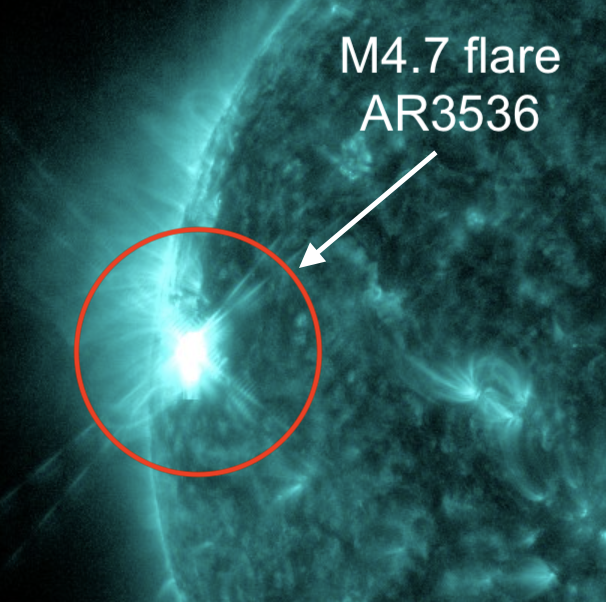

Sun news for January 1, 2024: X5 flare! Largest of Solar Cycle 25
Sun news January 1, 2024. X-flare! The EarthSky sun team produced this video. Thanks for watching!KABOOM! We’ve got an X5 flare, the strongest flare of Solar Cycle 25 so far! We thought the incoming region on the sun’s east limb (edge) would bring excitement. And, boy, did it deliver. The new region, AR3536, released an X5 flare at 21:55 UTC on December 31, 2023. What an appropriate Happy New Year as we start 2024. The eruption produced an EIT or coronal wave, that rippled across the face of the sun in all directions. It’s indicative of a coronal mass ejection (CME), a great burp of solar material. And initial analysis does show an Earth-directed component, which is expected to arrive midday tomorrow, January 2, 2024. Solar energetic particles are measured, presumably from the X5 event, but they haven’t reached radiation storm levels. AR3536 produced all but one of 17 solar flares of the past day (11 UTC yesterday to 11 UTC today). But the flares are mostly small C flares. Stay tuned.
Last 24 hours: Sun activity is now high, due to yesterday’s X5 flare from AR3536. The flare was released at 21:55 UTC on December 31, 2023. This is the largest flare of the current solar cycle, Cycle 25. It produced an R3 (strong) radio blackout over the Pacific Ocean. The eruption produced a coronal mass ejection (CME) with an Earth-directed component expected to arrive tomorrow, January 1, 2024. A noticeable coronal or EIT wave came from the region, rippling across the face of the sun in all directions. There is a slight increase in solar energetic particles presumably due to the event, but they do not reach radiation storm levels. Region AR3536 produced 16 of 17 flares observed over 24 hours (11 UTC yesterday to 11 UTC today) including the X5 flare and an M1 flare. The sun has four numbered sunspot regions on its Earth-facing side.











